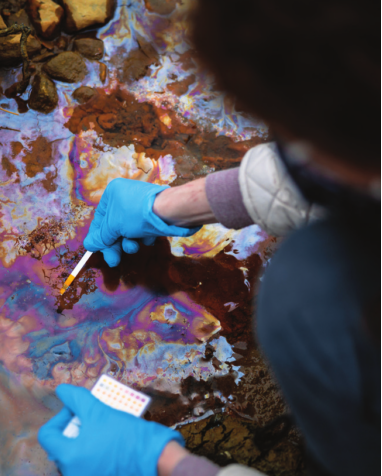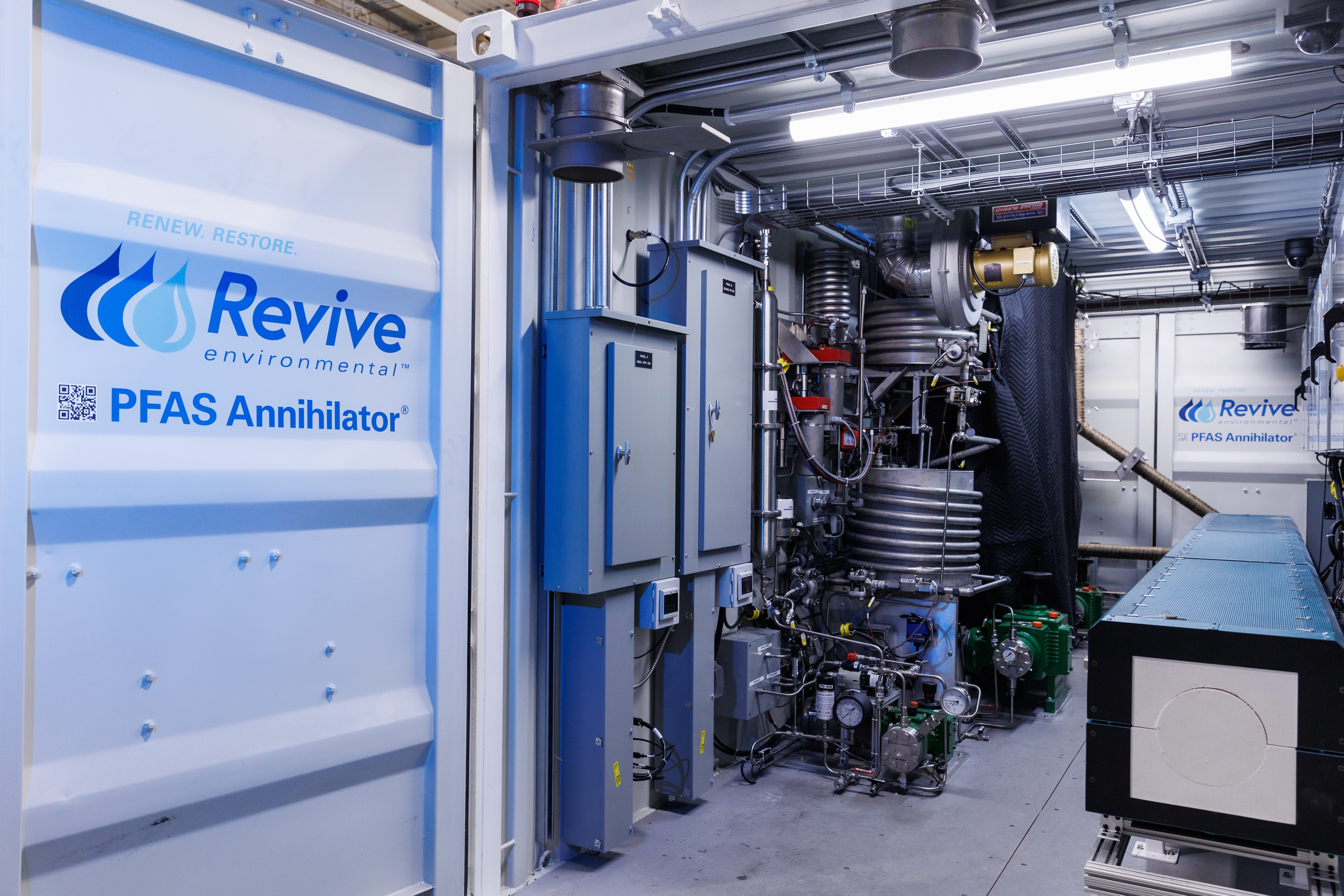Partnership launches PFAS Annihilator to ease chemical effects
A new partnership combines PFAS-busting technology with logistics and development services to help ease the growing effects of what are called “forever chemicals.”
The partners are Northeast Purification Systems (NEPS), based in Newington, and Revive Environmental in Columbus, Ohio.
Revive has the PFAS buster, with trademarked technology called the PFAS Annihilator. NEPS is a waste logistics and hauling company with access to development and construction services. Together, they say they can provide complete end-to-end PFAS liability management solutions throughout New England.
“NEPS could not be more excited to be partnering with Revive Environmental to provide first-class PFAS treatment services in New England,” said Mark Sanborn, NEPS partner and director of government relations. Sanborn is a former assistant commissioner at the NH Department of Environment Services, having left the job in September to join NEPS.
“As federal, state and local governments continue to evaluate the standards they will be requiring for PFAS contamination, we believe the treatment services offered by Revive and NEPS will be an effective solution for public and private sector organizations to meet these new requirements along with the ever-changing expectations of the public at large,” he added.
PFAS is a collective term for per- and polyfluoroalkyl substances, synthetic compounds that have been around since the 1950s and are used in everything from clothing and furniture to cookware and firefighting foam. These compounds are in water, air, soil and fish, and they break down very, very slowly, thus the term “forever chemicals.”
PFAS strains have been identified as being risks for certain cancers (prostate, kidney and testicular) as well as other possible ill effects from liver and kidney disease, altered thyroid function and diminished auto immunity.
In talking about the hopes for the partnership, Sanborn said, “PFAS is everywhere, but no longer forever.”
“From my perspective, as someone who used to be a regulator and now wants to bring a solution to the table, I want folks to get over the idea that we can’t find a solution,” said Sanborn. “For a while the conversations about PFAS were ones of helplessness, not knowing what to do. And in all the conversations we have, we try to reassure folks that there can be a solution, and we think we can be part of that solution.”
Revive’s Annihilator is a mobile, closed-loop system that uses supercritical water oxidation (SCW0), high temperature and pressure to break apart the fluorine links for total PFAS destruction. The process can be applied to water, landfill leachate and to firefighting foam, known technically as aqueous film-forming foam (AFFF).
“We end with zero, non-detect is the goal,” said David Trueba, president and CEO of Revive.
“How we remediate PFAS needs to be different,” he said. “In the past you could capture it and move it somewhere, but you’re not actually removing the PFAS. You could do things like thermal incineration that vaporizes the PFAS, put it into a different form, but it doesn’t actually destroy all the PFAS. A third option is to do nothing.”
The better option, as seen by Revive, is to identify the source and concentration of the PFAS and destroy it completely.
To address any issues of liability, a certificate that attests to the destruction will be issued as part of the services.
Revive has developed two trademark solutions — one being the Annihilator, the other being a GAC Renew.
GAC is granular activated carbon, which public systems use in the process to draw PFAS out of water.
But the issue is: What to do with the carbon filters with all that PFAS?
Revive says its GAC Renew technology regenerates spent GAC on-site, extending its life span, minimizing downtime and reducing the total cost of ownership by driving down operational expenses.
The Annihilator process then ensures the PFAS-laden waste stream is responsibly eliminated for a complete GAC restoration solution.
New Hampshire has two notable PFAS hot spots — at the Pease International Tradeport (formerly the Pease Air Force Base) in Portsmouth and Newington, and in the area of Saint-Gobain Performance Plastics in Merrimack.
PFAS from firefighting foam used at the former airbase leached into a municipal well, contaminating the water that unsuspecting users ingested unknowingly for many years before the well was shut down in 2014. Pease remains an EPA Superfund site and, as such, any soils excavated during any kind of development must remain on the site; they cannot, because of their possible PFAS contamination, be trucked away.
The Saint-Gobain plant was responsible for contaminating drinking water in some New Hampshire communities with PFAS; it plans to close the plant as it works with the state on an ongoing environmental investigation and mitigation.

Technology in this PFAS Annihilator from Revive Environmental destroys what had been considered ‘forever chemicals,’ now partnered with Northeast Purification Systems in Newington. (Courtesy photo)
In April, the U.S. Environmental Protection Agency (EPA) finalized new regulations on how much PFAS is allowed in drinking water. It set 4.0 parts per trillion for PFOA and PFOS, individually, as the enforceable Maximum Contaminant Levels (MCLs). This standard reduces exposure from these PFAS in drinking water to the lowest levels the EPA says is feasible for effective implementation.
In its partnership with Revive, NEPS will provide logistics, business development, facility development and management, and government relations and permitting services. Sanborn’s two other partners are Jake McManus and Ben Johnson from North & South Construction Services, which is also based in Newington.
According to NEPS, it targets multiple PFAS waste streams including landfill leachate, industrial wastewater and AFFF, and meets clients on-site to help develop solutions for complete destruction. It will then assist in the permitting process and design and construct the on-site Annihilator.
According to McManus, the plan is to create a hub and spoke Annihilator plant somewhere in the region within the next 18 to 24 months.
Sanborn said the group is on a parallel track to build a customer base of businesses and municipalities who might benefit from their PFAS-busting services while also looking for and getting permits for a plant site.
“The safety of the public and environment is paramount to what we’re doing,” said Sanborn. “We are a green solution to an environmental problem. So we match up building the business and identifying customers with doing the necessary work to do the permitting, to find the right location, and to deploy an Annihilator in the hub and spoke model in a way that is efficient and cost effective and safe for the environment and the public.”
The group is already addressing the firefighting foam with a state-sponsored program to remove and dispose of 10,000 gallons stored AFFF through a takeback program with municipal fire departments throughout New Hampshire. With approval this month by the Governor’s Council, the stored foam will be transported to an Annihilator site in Michigan for destruction.
Revive deployed the Annihilator site at a plant owned and operated by Heritage-Crystal Clean in Wyoming, Michigan, in May 2023.
According to Sanborn, the work being done in Michigan is proof positive that the Annihilator technology works in addressing an environmental danger and that it can be deployed locally in a safe manner.
Revive itself was launched in January 2023, the result of a partnership between Battelle, a biotech research organization, and Viking Global Investors.
“We are thrilled to partner with NEPS to make complete PFAS destruction a reality in New England,” Trueba said when the partnership was announced in March. “Organizations are facing significant risks from PFAS, and this partnership will enable them to responsibly and confidently destroy PFAS, eliminating liability and making water safe for all.”
The PFAS Annihilator process ensures the PFAS-laden waste stream is responsibly eliminated.